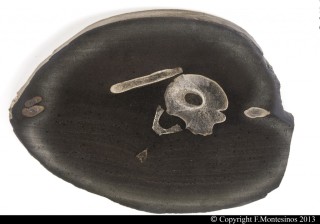Microbial communities

We investigate lipids and biomarkers and stable isotopic signatures (C, H, S and N) preserved in microbialites from the modern environment and ancient rock record. Microbialites are formed by the action of microbial communities through binding and trapping and/or by in situ precipitation of minerals.
Microbial communities can also form concretions that can contain intact fossils- morphological fossils. We have been studying the role of microbial communities in particular Chlorobi (green sulfur bacteria) and sulfate reducing bacteria through analyses of their biomarkers e.g. isorenieratane and maleimides. In fact we have observed the entire diagenetic continuum of sterols to steroids (70 components) in a Crustacean fossil encapsulated in a 380 million year old concretion from the Devonian Gogo Formation, Canning Basin, WA associated with the end-Devonian mass extinction event.
We attribute the coexistence of steroids in a diagenetic continuum to microbially mediated eogenetic processes (in the water column). We are also investigating the small subunit ribosomal RNA gene fragments and lipid biomarkers in various concretions from different periods of the geological record. We are also investigating modern microbialites from Shark Bay and Lake Clifton, WA. Microbialites/ concretions within shales associated with mass extinction events and Global Oceanic Anoxic Events (OAEs) are being thoroughly investigated to provide clues about the evolution and preservation of life (including the oldest preserved intact molecules) throughout geologic time.
Examples of publications
Grice K., Gibbison, R., Atkinson, J.E., Eckardt, C.B., Schwark, L., Maxwell, J.R. 1996. 1H-pyrrole-2,5,-diones (maleimides of anoxygenic photosynthesis in paleowater columns. Geochimica et Cosmochimica Acta 60 3913-3924.
Grice, K., Cao, C., Love, G.D., Bottcher, M.E., Twitchett, R.J., Grosjean, E., Summons, R.E., Turgeon, S., Dunning, W.J., Yin, Y. 2005. Photic zone euxinia during the Permian-Triassic Superanoxic event. Science 307, 706-709.
Melendez, I., Grice, K., Schwark, L. 2013. Exceptional preservation of palaeozoic steroids in a diagenetic continuum. Nature Scientific Reports 3.
Melendez, I., Grice, K., Trinajstic, K., Ladjavardi, M., Thompson, K., Greenwood, P.F. 2013. Biomarkers reveal the role of photic zone euxinia in exceptional fossil preservation: An organic geochemical perspective. Geology 41, 123-126.
Pagès, A., Grice, K., Vacher, M., Bennett, W.W., Greenwood P.F. 2014. Characterizing microbial communities and processes in a modern stromatolite (Shark Bay) using lipid biomarkers and two-dimensional distributions of porewater solutes. Environmental Microbiology, 16, 2458-2474.
Pagès, A., Grice, K., Jahnert, R., Ertefai, T., Skrzypek, G., and Greenwood, P.F., 2014. Organic geochemical studies of modern microbial mats from Shark Bay – Part I. Influence of depth and salinity on lipid biomarkers and their isotopic signatures. Geobiology 12, 469-487.
Pagès, A., Welsh, D.T. Teasdale, P.R. Grice, K., Vacher, M., Bennett, W.W. and Visscher, P.T. 2014. Diel fluctuations in solute distributions and biogeochemical cycles in hypersaline microbial mats from Shark Bay, Western Australia. Marine Chemistry 167, 102-112.
Tulipani, S., Grice, K., Greenwood, P.F, Haines, P., Sauer, P., Schimmelmann, A., Summons, R.E., Foster, C.B. Böttcher, M.E., Playton, T., and Schwark, L. 2015. Changes in palaeoenvironmental conditions in Late Devonian Reef systems from the Canning Basin, WA: A biomarker and stable isotope approach. Gondwana Research, in press.
